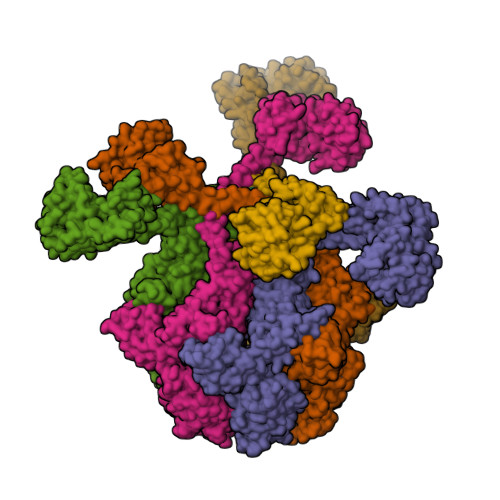A 5+1 assemble-to-activate mechanism of the Lon proteolytic machine.
Li, S., Hsieh, K.Y., Kuo, C.I., Lin, T.C., Lee, S.H., Chen, Y.R., Wang, C.H., Ho, M.R., Ting, S.Y., Zhang, K., Chang, C.I.(2023) Nat Commun 14: 7340-7340
- PubMed: 37957149
- DOI: https://doi.org/10.1038/s41467-023-43035-2
- Primary Citation of Related Structures:
7YPH, 7YPI, 7YPJ, 7YPK, 7YUH, 7YUM, 7YUP, 7YUT, 7YUU, 7YUV, 7YUW, 7YUX, 8K3Y - PubMed Abstract:
Many AAA+ (ATPases associated with diverse cellular activities) proteins function as protein or DNA remodelers by threading the substrate through the central pore of their hexameric assemblies. In this ATP-dependent translocating state, the substrate is gripped by the pore loops of the ATPase domains arranged in a universal right-handed spiral staircase organization. However, the process by which a AAA+ protein is activated to adopt this substrate-pore-loop arrangement remains unknown. We show here, using cryo-electron microscopy (cryo-EM), that the activation process of the Lon AAA+ protease may involve a pentameric assembly and a substrate-dependent incorporation of the sixth protomer to form the substrate-pore-loop contacts seen in the translocating state. Based on the structural results, we design truncated monomeric mutants that inhibit Lon activity by binding to the native pentamer and demonstrated that expressing these monomeric mutants in Escherichia coli cells containing functional Lon elicits specific phenotypes associated with lon deficiency, including the inhibition of persister cell formation. These findings uncover a substrate-dependent assembly process for the activation of a AAA+ protein and demonstrate a targeted approach to selectively inhibit its function within cells.
Organizational Affiliation:
Department of Urology, The First Affiliated Hospital of USTC, MOE Key Laboratory for Cellular Dynamics, Center for Advanced Interdisciplinary Science and Biomedicine of IHM, Division of Life Sciences and Medicine, University of Science and Technology of China, 230001, Hefei, China. lishanshan@ustc.edu.cn.




















